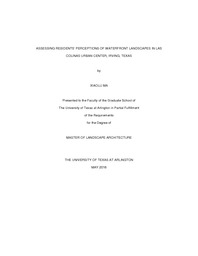| dc.description.abstract | The purpose of this study is to assess the residents’ perceptions of the waterfront landscapes in man-made environments, specifically in the Las Colinas Urban Center, Irving, Texas. From in-depth interviews and passive observations, this research identifies and reviews the specific landscape design characteristics of waterfront landscapes that influence people’s decisions to live near water. These specific landscape design characteristics are categorized into three dimensions: elements and features, water characteristics, and accessibility. Understanding how these three dimensions influence intention to live in close proximity to a waterfront landscape are used to provide recommendations for the future design of waterfront development.
Most ancient societies flourished in waterfront areas, such as next to the Nile, the Tigris, and the Euphrates, and they did so because of reasons such as transportation, agriculture, safety, and aesthetics. Because most people seem to enjoy living close to the water, many famous cities are located around waterfront areas. Various researchers have discussed the design characteristics that make the waterfront landscape more attractive, such as accessibility, feeling of safety (Butler, 2001), picturesque and memorable scenes (Gabr, 2002), and connectivity (Graham et al., 2009). Moreover, successful waterfront landscape projects offer numerous benefits to their nearby residents (Hou, 2009). For example, they can improve the environment by providing an attractive place for people to gather and increase revenue by promoting job opportunities and accelerating new investments (Hou, 2009). This research is an attempt to understand such conditions in the man-made waterfront environment.
This research uses qualitative methods to assess the waterfront landscapes of the Las Colinas Urban Center in Irving, Texas. Resident perception is assessed using in-depth interviews (Taylor and Bogdan, 1998) while passive observation techniques (Francis, 2002) are used to record and document the researcher’s observations of the landscape design characteristics of waterfronts. The in-depth interviews specifically focus on the residents’ perceptions of the landscape design characteristics of the Las Colinas Urban Center in terms of waterfront elements and features, water characteristics, and accessibility. Interview data are analyzed according to the grounded theory approach (Taylor and Bogdan, 1998). After the interview data are transcribed, key words are used to draw themes (Sommer, 1991). The observations of the landscape design characteristics, including the water body, edges, pathways, connections between the multi-family residences and the waterfront, sitting spaces, and the planting materials, are recorded in photographs. These data from the observations and the data from the interviews are compared with secondary data from the literature review to examine the residents’ perceptions of the landscape design characteristics of the Las Colinas Urban Center.
In conclusion, according to the results of this research, the landscape design characteristics of Las Calinas Urban Center do have a strong impact on people’s decisions about their living area. Therefore, during the design process, developers and designers should fully consider the resident’s perceptions of man-made waterfront projects so they can both benefit the users and enhance the further development around it. | |


